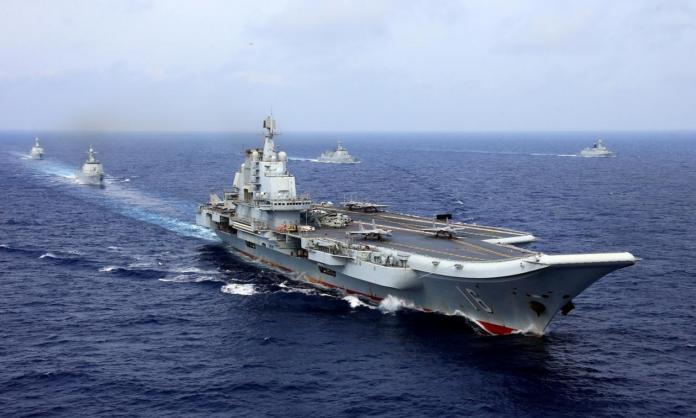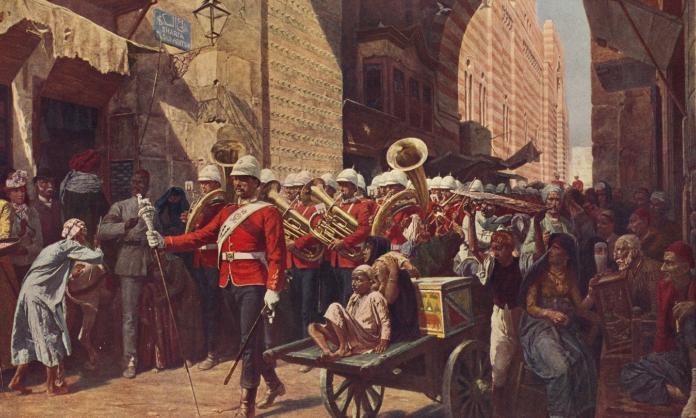Tensions between the United States and China are escalating rapidly. The ongoing rift between the world’s two largest powers has intensified during the COVID-19 crisis, as both countries jostle for position in a rapidly changing political climate. There is a growing consensus among the US ruling elite for a hardline approach to China’s rapid rise. A new White House report outlining a more aggressive stance, which may prove to be the most significant foreign policy document since 9/11, has been co-signed by every relevant federal department.
The United States Strategic Approach to the People’s Republic of China laments that the dominant approach of the last 40 years to integrate China into the liberal international framework overseen by the US has failed to open the country politically or economically. “The CCP [Chinese Communist Party] has chosen instead to exploit the free and open rules-based order and attempt to reshape the international system in its favour”, the report states. “Beijing openly acknowledges that it seeks to transform the international order to align with CCP interests and ideology. The CCP’s expanding use of economic, political, and military power to compel acquiescence from nation states harms vital American interests and undermines the sovereignty and dignity of countries and individuals around the world.”
China has an appalling record of human rights abuses, including the incarceration and oppression of the Uyghur population, the occupation of Tibet, growing control of Hong Kong and repression and mass surveillance of its domestic population. But the USA’s claim to be the global enforcer of a more progressive order is rubbish. No other country in history has bombed as many countries, starved as many people, oppressed as many groups as the United States. The US is concerned primarily about its own position.
China’s meteoric rise from an impoverished, largely rural country to the second largest global power has struck fear into the hearts of US elites for more than a decade. Since the economic reforms and opening to foreign capital under Deng Xiaoping in the 1980s, the Chinese economy has grown faster than any historical precedent. In 2010, China overtook Japan as the world’s second largest economy. The country once denigrated as the world’s sweatshop became home to nine of the top 20 biggest tech companies in 2018. Xi Jinping’s trademark industrial policy, Made in China 2025, aims to develop rapidly 10 high tech industries.
As with the United States at the turn of the 20th century, China’s economic boom is translating into growing military and geopolitical strength. Over the past 10 years, Beijing has almost doubled its military budget, to US$266 billion. While Washington spends far more ($719 billion), the gap between the two has narrowed. The US remains far in advance in global military reach, with around 800 military bases dotted across the globe. By contrast, China has only one foreign base, in Djibouti. But Beijing’s military prowess is growing.
Its hallmark Belt and Road Initiative (BRI) has drawn the most ire from Western adversaries. The BRI is a large-scale investment program to open six economic corridors, linking China to Europe, Central Asia and the Middle East by land, and to the Indian subcontinent, South-East Asia, the Pacific and east Africa by sea. An estimated US$1 trillion has been pledged for the project thus far, involving 138 countries. Gianghui Gu, writing at the Conversation, explains that the BRI “allows China to redress economic imbalances between its coastal and interior provinces, find outlets for excess production capacity and internationalise the Chinese currency”.
Of more concern to the US is its use in building China’s influence. As a latecomer to the stage of great powers, Beijing’s global reach is out of kilter with the sheer size of its economy. But economic strength can buy geopolitical influence, as the US knows all too well – Washington’s global dominance was cemented by US finance following the Second World War. China is now the world’s largest financier, surpassing the World Bank and International Monetary Fund, the traditional heavyweights of US finance. In early June, China announced the suspension of debt repayments for 77 developing nations; no doubt this will help Beijing build its political capital, while US president Donald Trump continues to tell the rest of the world it’s America First.
A seismic shift has also taken place in the relationship between US businesses and the Chinese state. Low wages and few restrictions on investment in its special economic zones made China the land of riches for US corporations, particularly those producing labour-intensive consumer goods such as clothing, toys and household items. The liberalisation of the Chinese economy also opened a huge domestic market for US firms to sell their products. As Bob Davis and Lingling Wei, writing for the Wall Street Journal, explain, “When Congress was voting on a bill that would ease China’s entry into the World Trade Organization in 2000, big [US] firms spent $100 million to lobby for approval”.
But the momentum enriching US firms in China also, ironically, created a competitive advantage for their Chinese rivals. Local suppliers began to undercut foreign firms by selling direct to retailers, and the benefits of a state-directed economy allowed Chinese capital to flourish while Western capital faltered. Beijing unleashed mass stimulus spending to stave off the global financial crisis in 2008, further undercutting foreign firms by flooding international markets with cheap commodities such as steel and glass. “By 2014”, write Davis and Wei, “just one-third of members of the American Chamber of Commerce in China said they were optimistic about their two-year prospects in China, about half the percentage of 2008”.
Fears of China’s rise are far from new. In 2001, US defense secretary Donald Rumsfeld helped pen a Pentagon report warning of the country’s potential threat to US global dominance and recommending the Pacific Ocean become the focal point of military deployment. But the strategy was shelved after president George W. Bush failed to win swiftly his invasions of Afghanistan and Iraq in the Middle East.
“In a sense, the attacks of September 11 took a lot of pressure off China, and gave China a lot of run room to modernise, to develop, to expand its influence both in the region and more broadly”, noted former National Security Council director for China Ryan Hass in a 2019 podcast for the University of Pennsylvania Center for the Study of Contemporary China. “It diverted $6 trillion of US resources to the Middle East ... Many of our Chinese friends talk of the good fortune they had.” On the 2016 campaign trail, Trump attacked Bush’s disastrous Iraq war and was loudly opposed by Republicans and the national security establishment. Now, a senior strategist under the Obama administration is in effect saying that Trump was right.
Obama later tried to redirect US foreign policy with his “pivot to Asia”, aiming to expand US economic and military clout in China’s backyard. But, bogged down by endless war and occupation in the Middle East and struggling with the aftermath of the global financial crisis, the US faltered. Obama’s strategy was guided by the then-dominant view of foreign policy advisers. John Bolton, former national security adviser to president Trump, writing in the Wall Street Journal, says the consensus held to two flawed propositions:
“The first is that the Chinese economy would be changed irreversibly by the rising prosperity caused by market-oriented policies, greater foreign investment, ever-deeper interconnections with global markets and broader acceptance of international economic norms. The second proposition is that, as China’s national wealth increased, so too, inevitably, would its political openness. As China became more democratic, it would avoid competition for regional or global hegemony ... Both propositions were fundamentally incorrect.”
To underline the growing consensus, Kurt Campbell and Ely Ratner, two former advisers in the Obama administration, wrote in a 2018 Foreign Affairs article that the basic principles guiding Obama’s China strategy were wrong.
Since Trump took office, criticism of his approach to China has often been that he’s not hard enough. While the Democrats denounced tariffs on their European and North American allies, the same was not true for the trade war with China. In response to Trump’s first memorandum demanding tariffs on Chinese goods in March 2018, Democratic leader Nancy Pelosi said: “The United States must take strong, smart and strategic action against China’s brazenly unfair trade policies. Yet, today’s announcement is merely a start, and the Trump administration must do much more to fight for American workers and products”. And when vice president Mike Pence delivered a ferocious speech about China to the Hudson Institute in 2018, it was dubbed an announcement of a new Cold War by political pundits across the board. No US elites jumped to condemn Pence’s rhetoric.
There are still differences in emphasis and tactics among the US ruling class. US trade groups are against the tariffs, representing companies that have taken a financial hit. Bolton writes that Trump’s advisers are “badly fractured intellectually” between “‘panda huggers’ like Treasury Secretary Steven Mnuchin; confirmed free-traders like National Economic Council Director Larry Kudlow; and China hawks like Commerce Secretary Wilbur Ross, lead trade negotiator Robert Lighthizer and White House trade adviser Peter Navarro”.
Hunter Dorwart in Asia Times writes: “Republican hawks favor taking a more aggressive posture on China while abandoning some of the multilateral approaches taken by previous generations, [whereas] Democrats ... want to confront China by building stronger partnerships with trusted regional allies while developing alternative supply chains for the US business community”. Despite an emerging consensus that integration has been futile and that aggression is now required to maintain US imperial dominance, no one knows exactly what to do. The past few months have made clearer that Beijing will not be cowed by US sabre rattling.
While the depth and breadth of the economic crisis engulfing the globe are still unclear, leading economists agree that it is already monstrous. The reliance on global supply chains has been thrown into question, and many world leaders are speaking in a language not far removed from Trump, saying it’s time for a return to national manufacturing.
Early predictions that COVID-19 could be Xi Jinping’s Chernobyl moment were quickly shelved as Beijing managed to contain the virus. Meanwhile, the pandemic is still ravaging the US, further exposing its weaknesses to international allies and adversaries. Financial pages now carry opinion pieces questioning the long term viability of the US dollar as the global reserve currency. Such thoughts were almost unthinkable in the mainstream 12 months ago.
No matter which way you look at it, competition between the world’s two superpowers is intensifying. And behind the open competition over trade, technology, surveillance and geopolitical influence lies the threat of military confrontation. While neither side is about to declare war, both are developing their military arsenals with an eye to the future. The prospect of a new cold war boiling over would mean unimaginable devastation for humanity.










